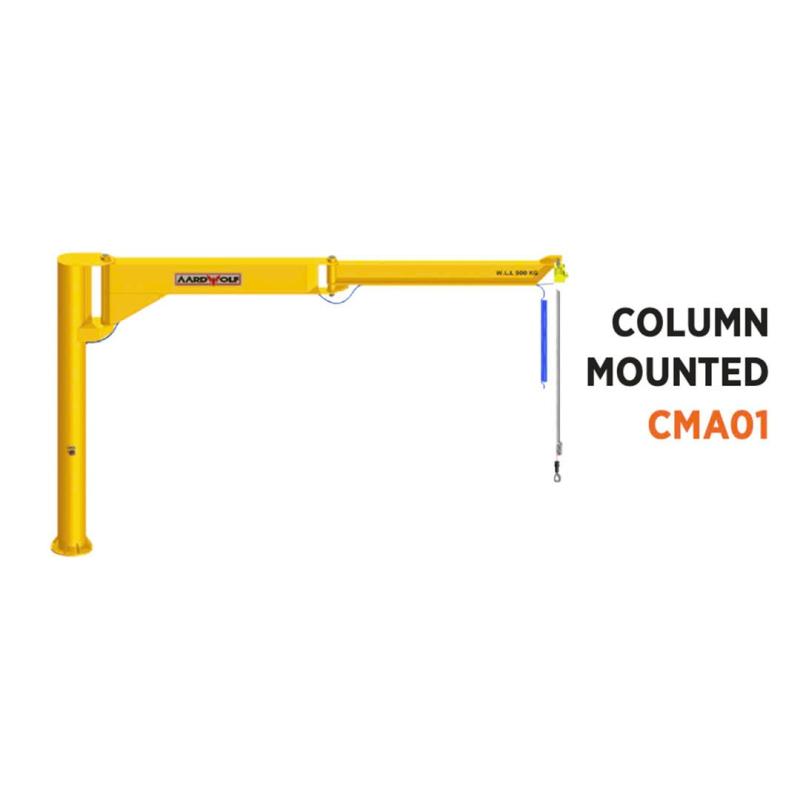



Among the various lifting tools available—such as hoists and davit arms—jib cranes stand out for their superior versatility, capacity, and adaptability in a wide range of industries. But when exactly should you choose a jib crane over other lifting solutions like a hoist or davit arm?
In this guide, we’ll explore the technical and operational benefits of jib cranes, identify key use cases where they outperform their alternatives, and provide tips for selecting the right model for your facility.
Jib cranes are material handling devices featuring a horizontal arm (called a boom or jib) mounted to a vertical support. The boom rotates around the mast, allowing for radial coverage of a designated workspace. They can be freestanding, wall-mounted, ceiling-mounted, pillar-mounted, or articulating, depending on the facility’s layout and operational needs.
For more information on available configurations, refer to this Jib Cranes specification guide.
360° or 180° Rotation: Depending on the type, jib cranes offer partial or full rotation for flexible positioning.
High Load Capacity: Suitable for lifting from 125 kg to several tons.
Customizable Arm Length and Height: Adaptable to specific workspace layouts.
Improved Ergonomics: Reduces manual lifting and enhances operator safety.
Floor Space Optimization: Especially for wall- or ceiling-mounted models.
| Feature | Jib Cranes | Hoists | Davit Arms |
|---|---|---|---|
| Rotation Range | 180°–360° | Limited (vertical lift only) | Usually up to 360° |
| Mounting Options | Floor, wall, ceiling, column | Ceiling beams, trolleys | Fixed base or portable bases |
| Best for | Repetitive lifting, precise placement | Vertical lifting only | Light-duty edge lifting |
| Load Capacity | Up to several tons | Varies by hoist type | Generally low to moderate |
| Space Requirement | Low (especially wall- or ceiling-mounted) | Low | Moderate |
| Application Flexibility | High – multiple types of environments | Medium – vertical use only | Low – niche or limited use cases |
In small workshops or fabrication environments, wall mounted jib cranes are often installed alongside machinery to lift parts into position without needing floor space. One notable solution is the Wall-mounted Jib Crane , a compact and powerful model ideal for localized lifting applications.
Use Case: A metal fabrication plant in Victoria integrated this crane into their cutting station, achieving a 30% reduction in handling time for metal sheets.
In environments filled with machinery or structural beams, an articulating jib crane with its dual-pivot arm can navigate around obstructions. Aardwolf’s Articulated Jib Crane Wall Mounted is a popular choice in assembly lines and automotive workshops.
Use Case: An automotive assembly facility in Melbourne used this model to precisely install engine blocks in tight engine bays with just one operator.
For facilities without adequate wall or ceiling support, freestanding jib cranes offer unmatched flexibility. These cranes are anchored to a concrete foundation and can rotate 360°, making them suitable for packaging, palletizing, or CNC machine loading zones.
Use Case: A logistics center in Brisbane installed a freestanding jib crane to speed up palletizing. Its independent design required no structural modification.
Before choosing a jib crane, it’s essential to evaluate the facility’s structural integrity and the operational footprint available. Ceiling-mounted and wall-mounted variants are ideal for space-restricted facilities but require careful planning and installation.
Check this step-by-step guide to ensure proper setup and safety compliance.
Despite their versatility, jib cranes aren’t always the most suitable option. In scenarios where:
Only vertical movement is required
The load is minimal (e.g., < 100 kg)
The lift must extend over a balcony, trench, or ship deck
—hoists or davit arms may offer more compact or portable alternatives.
However, they fall short in:
Radius and flexibility of movement
Repeatability in industrial tasks
Safety and automation integration
Match the crane's WLL (Working Load Limit) with the heaviest object it must lift.
Calculate your working radius and lifting height based on machinery layout and overhead clearance. See this Jib Crane dimensions resource for detailed examples.
180° may suffice for wall-mounted units, but many applications benefit from full 360° freedom.
Consider weatherproofing, corrosion-resistant materials, or explosion-proof features depending on your industry.
| Scenario | Best Equipment |
|---|---|
| Repetitive lifting in production lines | Wall-mounted jib crane |
| Complex movement paths | Articulating jib crane |
| No structural wall support | Freestanding jib crane |
| Occasional vertical lifts | Hoist |
| Edge lifting (e.g., tanks, wells) | Davit arm |
When operational efficiency, safety, and flexibility are key, jib cranes offer superior performance over hoists and davit arms in most industrial applications. From freestanding units on warehouse floors to wall-mounted cranes in tight workshops, Aardwolf delivers a complete lineup tailored to the demands of modern manufacturing and logistics environments.
Explore available Jib Cranes specification and learn the difference between jib cranes and overhead cranes to make an informed purchase.
Have questions about which jib crane model is right for your facility? Reach out to Aardwolf’s technical team for tailored recommendations and installation guidance.
References
1. How to operate a Jib Cranes safely
3. Over brace jib crane wall mounted
5. Is a Jib Crane a Gantry Crane
6. Articulated Jib Crane Wall Mounted
8. Manual Counterbalance Crane
10. Over Braced Jib Crane Column Mounted
Đăng ký để nhận thông tin mới nhất về sản phẩm Aardwolf, ưu đãi đặc biệt và nhiều hơn nữa.
Bằng cách đăng ký, bạn đồng ý nhận email từ Aardwolf với tin tức, ưu đãi đặc biệt, khuyến mãi và thông tin khác. Bạn có thể hủy đăng ký bất cứ lúc nào.